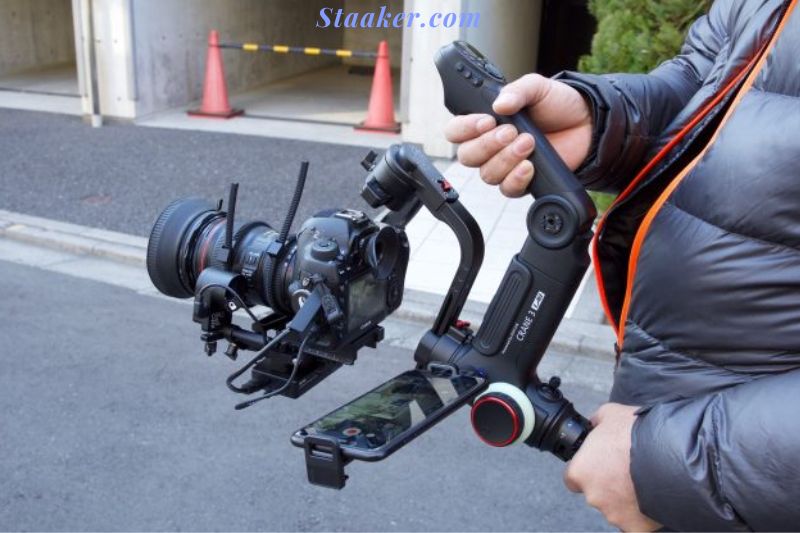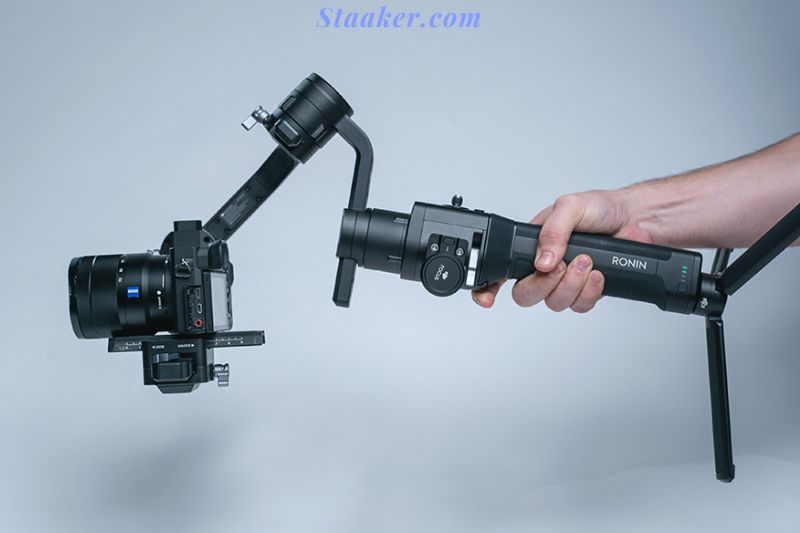Regarding stabilizers for DSLR and mirrorless cameras, two brands stand out above the rest: Zhiyun and DJI. Both companies make high-quality products that are popular with professionals and enthusiasts alike.
But which one is the best? This article will pit the Zhiyun Crane vs DJI Ronin and see which one comes out on top.
Zhiyun Crane 2 Vs Ronin-S

Performance Stabilization And Monitoring
After lengthy testing with my Nikon D850, I found that the two gimbals performed nearly identically in stabilization. The Ronin-S film appeared smoother on some playbacks, but the Crane 2 footage appeared better on others. In any event, the difference was too little to notice with the naked eye.
On the other hand, the Ronin-S had substantially faster AI tracking performance. The Crane 2 wasn’t horrible by any means, but there were moments when I was filming my dog play retrieve, and the Crane 2 would take its time catching up, leaving the dog missing from a few frames.
Payload Maximum
The Zhiyun Crane 2 has a payload capacity of up to 7 pounds (3200g). The Ronin-S can hold up to 8 pounds (3600g).
Most DSLR setups should be acceptable with any gimbal, but those using heavier cine lenses, shotgun mics, gimbal monitors, and other accessories will benefit from the Ronin-S.
Construct With Quality And Ergonomics In Mind
The Crane 2 and the Ronin-S are made of rigid metal, but the Ronin-S feels more substantial in the hands. However, neither the Crane 2 nor the Ronin-S have had any significant build quality issues, so it’s safe to conclude that neither gimbal will break apart while filming.
Both gimbals are comfortable to use. However, the Ronin-S has a little more comfortable grip. The Ronin-S features an ergonomically designed grip. The Crane 2’s grip is just a metal cylinder, making it difficult to tell if you’re holding it entirely straight because it feels the same everywhere.

Weight and Portability
For individuals who frequently travel and shoot for extended periods, weight and portability are critical considerations.
The Crane 2 weighs 2.76 lbs, while the Ronin-S weighs 4.1 lbs (1.86 kg) (1.25 kg). The change isn’t significant, and the gimbal’s weight is only a minor part of the overall setup’s weight. However, the weight you save with the Crane 2 will significantly minimize fatigue.
The Crane 2 is lighter than the Ronin-S but doesn’t pack down. DJI has made removing the base/grip from the gimbal head easy, making it simpler to fit into tighter spaces.
Camera Compatibility
Although both gimbals can steady footage for any camera that fits properly, compatibility assures that the gimbal can operate numerous camera functionalities appropriately.
The Ronin-S was formerly incompatible with Canon DSLRs. However, with the newest firmware, it now has complete interface compatibility. In the meantime, Zhiyun’s recent firmware upgrade included Nikon Z6 and Z7 support.
Accessories
There are numerous accessories available for the either gimbal. DJI and Zhiyun are the most well-known brands of DSLR/mirrorless gimbals, with a wide range of first- and third-party accessories.

A follow focus device, which physically pulls the focus ring on the barrel of a lens, is a popular video accessory. The Ronin-S didn’t come with a follow focus system when it was first released, but DJI has since released one.
The Servo Follow Focus accessory is included with the Zhiyun Crane 2. I haven’t used either and have been satisfied with autofocus, but more technically minded filmmakers will want to investigate the gimbals’ respective follow focus system options.
Battery Life
The Crane 2 is powered by three replaceable batteries that provide an 18-hour energy life when used simultaneously. On the other hand, the Ronin-S has a built-in battery that can last up to 12 hours.

Removable batteries are preferable because they may be recharged independently and allow the option of purchasing a backup set. The Ronin-built-in S’s battery, on the other hand, means that you don’t have to take out and replace the batteries every time you charge.
Price
The Crane 2 is the less expensive of the two at the time of writing. For slightly under $500, you can acquire the gimbal with the servo follow focus device.
Video
Zhiyun Crane 3 Vs DJI Ronin S
Many companies have debuted on the market, with many copycats put out in between, making it increasingly difficult to make an informed decision given all the available options. With their respective Ronin-S and Crane 3 Lab, DJI and Zhiyun-Tech are still two of the key competitors on the market.
Price
The first comparison discussed in the video is the most straightforward. When comparing the Ronin-S to the Crane 3, the Ronin-S comes out on top, not to mention the Ronin’s Essential Kit, which is a deal. Ronin has an easy win here, but the price isn’t everything.

Build Quality
When you hold the Ronin-S in your hand, it feels solid and solid. It’s entirely made of metal and has the appearance of being built like a tank. This isn’t to say that the Crane isn’t prone to snapping. Although the latter is made of high-quality polymers, the sensation it conveys is not on the same level as the Ronin-metal S’s body.
Crane’s design, on the other hand, is unmistakably original. Zhiyun has put in a lot of work to create a product that checks all the boxes. They fixed the screen obstruction and created an excellent low-mode handle. While some of these options are effective in specific instances, they should not be considered the definitive solution for all shooting scenarios.
Weight And Form Fator
The Crane wins the weight by half a pound, but that’s not all. The handle and the ability to lock the axis while moving are big-time savers. Both devices are small enough to fit in most backpacks, but the Crane wins.
Visibility On The Screen
This aspect, once again, has no bearing on the game. The Ronin had an advantage over the Crane 2 in its prior form, but the newest model tackles the issue by lowering the rear axis and cleaning up the view for the screen.

Usability In General
So, once it’s out of the bag, which gimbal will be easiest to set up and use? The Ronin appears to have won this round because of the companion app, which is far more refined and less buggy than the one built by Zhiyun-Tech.
The Crane is more accessible to balance because the locks above on the single axis make it quick to locate the proper location. The auto-tune ability and generally less weird interface make it easier to use.
Payload
On paper, the Crane has the higher payload of the two, at 10 pounds versus 8 pounds for the Ronin, but even if you could carry more weight, the form aspect of the camera would eventually make it hard to balance. In any case, this is a Crane 3 score.
Battery Life
The Ronin has much longer battery life. Its run time is about double that of the Crane, at 12 hours.
Controls For The Camera
Because the Crane allows you to connect the camera to the gimbal through a wire and alter some settings straight from the gimbal, it has a more substantial follow focus.
Although the settings on the Crane 3 Lab are only a few inches away from your fingertips, having the ability to change exposure mid-shoot without moving your hands can be a significant bonus, depending on the situation. So, Crane gets the point. We’ll see how the performances turn out.
Real Worl Performance
In this perspective, Wallbeck’s first test is a straight walk. He adjusts the gimbals so that the camera remains stable while moving forward and backward. Both competitors performed admirably on the challenge.
It’ll make all the difference in the world if you have perfect balance and use the suitable gimbal settings. Of course, like with any motorized gimbal, there are still hiccups in the footage caused by the operator’s vertical movement, but that’s part of the fun with these devices.
So we may declare this a tie. However, the DJI is the clear winner in the full-speed running test. Although both gimbals have some up and down motions, which is expected when jogging, the Ronin-S handles these more naturally.

Let’s take a look at Low Mode after we’ve done some jogging around. You reverse the gimbal and try to float around the ground a little bit, perhaps following someone’s footsteps. In this mode, Zhiyun wins due to superior ergonomics and ease of usage.
However, neither of them has an advantage in the parallax shot. What exactly is it, you might wonder? It’s a shot in which the camera pans one way while the entire gimbal system rotates the other, maintaining the subject in the middle. It’s a strong shot since it adds a lot of kinetic energy to your scene. With the stiffness of the motors reduced, both gimbals can quickly achieve it.
The 360° barrel roll, or Inception mode, as some refer, brings the sequence of movements to a close. The Crane shines brightly once more. The ergonomics and grip are superior, and the rotation mode is just a click away, whereas the Ronin-S requires you to open the app and set up the shot (not complicated, but much less streamlined).
Wind Resistance
This feature was tested outside the window of a moving car, and the results were good on both. Still, the identical handle that makes the Crane the best choice in the Barrell roll and Low mode here becomes an inconvenience between the camera and the operator, making holding the unit too awkward while keeping the operator’s torso outside the car.
Meanwhile, in sports mode, we earn the final point, which goes to Ronin again. Better tracking, less unwanted movement, and a better choice for fast-moving individuals.
Video
FAQs
Does the Ronin-S feature an active track?
The active track is an advantageous function of gimbals like the DJI Ronin S. It is now available with at least the January 2020 firmware upgrade for the DJI Ronin S!
How do I connect my mobile device to Ronin?
Turn Bluetooth on your phone and look for the Ronin-S. You may be required to enter a device password, “12345678.” To activate the gimbal, re-enter the app and follow the on-screen instructions. Double-tap the power button to activate the motors after completion.

How many pounds can the Zhiyun crane support?
Crane’s gimbal body weighs only 950g (batteries not included). In comparison, its permissible payload goes up to 1800g, making it compatible with almost all mirrorless cameras on the market, as well as select DSLR camera types, and permitting a multitude of lens combinations according to your shooting needs.
What is the lifespan of a Zhiyun Crane 2?
According to Zhiyun, the Crane 2S has a battery life of up to 18 hours of continuous usage.
If you want to see other compare articles to decision buying the gimbal:
Conclusion
In the end, the Zhiyun Crane is the best stabilizer for DSLR cameras. It has better performance and is more durable than the DJI Ronin. If you’re looking for a stabilizer that will help improve your photography, the Zhiyun Crane is the best option available.
So which stabilizer is right for you? Staaker.com hopes this article has helped you make a decision.

